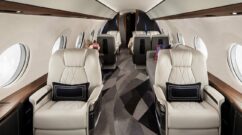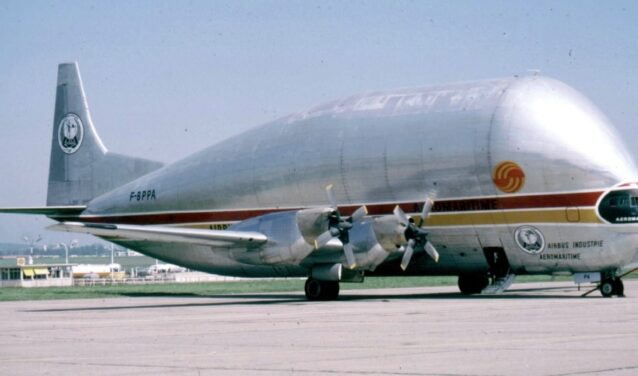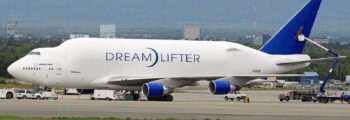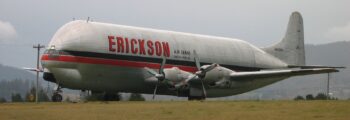Description of SUPER GUPPY
Want to know more about the Super Guppy?
The Super Guppy is a civil cargo aircraft built in the United States by Aero Spacelines in the 1960s. It can carry about 77 tons of large equipment and is often used for the transport of space components and technology.
NASA commissioned the first models as it needed to carry components and entire sections of the Saturn V rocket for the Apollo project. Transporting the rocket by boat was found to cause rust problems.
Building the Guppies
Aero Spacelines decided to build the “Pregnant Guppies” using old Boeing 377 Stratocruisers. However, they were too small and another aircraft was needed to transport the parts to the Cape Canaveral (Florida) launch base.
The current Super Guppy was built on the basis of a Boeing KC-97 and underwent many modifications; turboprops replaced the piston engines, the wings were lengthened and the fuselage reinforced. Unlike the Pregnant Guppy, the pressurisation was kept in the cockpit in order to fly at higher altitudes.
The aircraft entered service in 1966 and was purchased by NASA in 1979.
Five units were produced. Aero Spacelines launched in parallel the production of the Mini Guppy, intended for the transport of oversized cargo, and the Super Guppy Turbine. The latter was built to meet the demand of Unexcelled Corporation, which purchased Aero Spacelines in 1967.
A rapid evolution
The Super Guppy became, over the years, more and more difficult to maintain. Its main defect was that it was necessary to open its nose manually and to dismantle electrical cables during loading. This was a long and laborious operation. The freight aircraft was also built from the base of a much older plane and therefore some spare parts are no longer produced today. It also had an old-fashioned cockpit and compass system.
In the 1970s, Aero Spacelines experienced financial difficulties and traded with Airbus.
In 1996, the Super Guppies were replaced by five Beluga aircraft, more modern and quicker to unload. They then became museum pieces in different countries. One aircraft was entrusted to the Toulouse Old Wings collection, and three others were exhibited in the United States (Tucson), Germany (Hamburg) and Great Britain (Bruntingthorpe). The latest model is still operated by NASA.
Do you need a price estimate?
Request for quoteCommercial features of SUPER GUPPY
The Super Guppy is about 43 metres long, with a height of 15 metres and a wingspan of 47 metres.
Its shape resembles that of the Beluga and of the Boeing 747-400 LCT.
The Beluga has taken over on the Airbus side (front loading) and the Dreamlifter on the Boeing side (rear loading).
Estimate your flight online and receive your quote by email
Technical specifications of SUPER GUPPY
 Aircraft
Aircraft
- Manufacturer AERO SPACELINES
- Model SUPER GUPPY
- Classification Cargo Aircraft
 Useful information
Useful information
- Pilots 2
- Flight crew No
- Luggage compartment volume 1400 m³
 Performance
Performance
- Cruising speed 470 km/h
- Range 3 200 km
 Price
Price
- Purchase Price 2 200 000 €
Discover our online comparator
AEROAFFAIRES in figures
Renting private jets
since 1991
20 000
private jets
45 000
completed flights
120 000+
passengers
4,9/5
customer satisfaction
100%
carbon offsetting
Range of action of the SUPER GUPPY
Move the centre point on the map according to your starting position
Key Benefits of SUPER GUPPY
- The Super Guppy has a range of 3200 kilometres.
- It can carry a cargo of almost 80 tons.

Do you need a price estimate?
Request for quoteA question? Contact our airline experts

Isabelle CLERC
CEO AEROAFFAIRES

François-Xavier CLERC
Founder AEROAFFAIRES
Our airline experts remain at your disposal to help you at every stage of your reservation.









